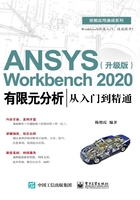
5.5 项目分析4——支承座静力学分析
本节主要介绍ANSYS Workbench的结构线性静力学分析模块,计算某支承座在受力情况下的应力分布。
学习目标:
熟练掌握ANSYS Workbench静力学分析的方法及过程。

5.5.1 问题描述
轴类件是机械结构中常使用的部件之一,与之配套的支承座也常出现在各类机构中,如图5-116所示。假设某支承座承受1000N的载荷,该支承座材料为铝合金。

图5-116 支承座
5.5.2 添加材料和导入模型
Step1:在主界面中建立分析项目,为静态结构分析(Static Structural)项目。双击分析系统(Analysis Systems)中的Static Structural命令,生成静态结构分析项目A,如图5-117所示。
Step2:双击项目A下面的Static Structural,将分析项目名称更改为“支承座”,如图5-118所示。

图5-117 静态结构分析项目A

图5-118 更改分析项目名称
Step3:双击A2栏的Engineering Data选项,进入如图5-119所示的材料参数设置界面,在该界面下即可进行材料参数设置。

图5-119 材料参数设置界面1
Step4:在界面的空白处右击,在弹出的快捷菜单中选择Engineering Data Sources(工程数据源)命令,此时的界面会变为如图5-120所示的界面。原界面中的Outline of Schematic A2: Engineering Data表消失,被Engineering Data Sources及Outline of General Materials表取代。
Step5:在Engineering Data Sources表中选择A4栏的General Materials选项,然后单击Outline of General Materials表中A4栏的Aluminum Alloy(铝合金)选项后的B4栏的![]() (添加)按钮,此时在C4栏中会显示
(添加)按钮,此时在C4栏中会显示![]() (使用中的)图标,如图5-121所示,表示材料添加成功。
(使用中的)图标,如图5-121所示,表示材料添加成功。
Step6:同Step4,在界面的空白处右击,在弹出的快捷菜单中选择Engineering Data Sources(工程数据源)命令,返回初始界面。
Step7:根据实际工程材料的特性,在Properties of Outline Row 4: Aluminum Alloy表中可以修改材料的特性,如图5-122所示。本实例采用的是默认值。

图5-120 材料参数设置界面2

图5-121 添加材料

图5-122 修改材料的特性
Step8:单击工具栏中的![]() 按钮,返回Workbench 2020主界面,完成材料库的添加。
按钮,返回Workbench 2020主界面,完成材料库的添加。
Step9:右击A3栏的Geometry选项,在弹出的快捷菜单中选择Import Geometry→Browse命令,在弹出的对话框中选择需要导入的模型zhichengzuo.x_t,如图5-123所示。

图5-123 导入模型
5.5.3 修改模型
观察该支承座模型,它的上下两部分是由两个简单的模型组成的。如果将该模型切开,则可以方便地使用Sweep(扫掠)方式划分较高质量的网格。
Step1:双击A3栏的Geometry选项,打开DesignModeler界面,在DesignModeler界面中单击![]() 按钮,生成支承座模型,如图5-124所示。
按钮,生成支承座模型,如图5-124所示。
Step2:选择需要加载的面,如图5-125所示。在背景中右击,从弹出的快捷菜单中选择Look At命令,调整绘图视角,如图5-126所示。

图5-124 支承座模型

图5-125 选择面

图5-126 选择Look At命令
Step3:选择Tools→Freeze命令,如图5-127所示。
Step4:切换到Sketching(草绘)模块,选择Draw→Line命令,如图5-128所示。

图5-127 选择Freeze命令

图5-128 选择Line命令
Step5:选择需要切割的两个点,绘制切割线,如图5-129所示。
Step6:单击常用命令栏中的Extrude按钮,如图5-130所示。

图5-129 绘制切割线
图5-130 单击Extrude(拉伸)按钮
Step7:在Details View面板的Operation栏中选择Slice Material选项,设置操作方式,如图5-131所示。
Step8:在Extent Type栏中选择Fixed选项,设置拉伸距离,如图5-132所示。

图5-131 设置操作方式

图5-132 设置拉伸距离
Step9:单击![]() 按钮,完成切割操作,此时几何体已经被切割完成。读者可尝试使用
按钮,完成切割操作,此时几何体已经被切割完成。读者可尝试使用![]() (体选择命令)来选择不同的几何体。
(体选择命令)来选择不同的几何体。
Step10:单击界面右上角的![]() 按钮,关闭Design Modeler界面。
按钮,关闭Design Modeler界面。
5.5.4 赋予材料和划分网格
Step1:双击项目A中A4栏的Model选项,打开Mechanical界面。
Step2:单击Outline中Geometry命令前的![]() 按钮,按住Ctrl键选择两个Solid命令,如图5-133所示。
按钮,按住Ctrl键选择两个Solid命令,如图5-133所示。
Step3:单击Details of“Multiple Selection”面板中Assignment栏后的![]() 按钮,如图5-134所示,选择Aluminum Alloy选项。
按钮,如图5-134所示,选择Aluminum Alloy选项。

图5-133 选择Solid命令

图5-134 更改材料
Step4:选择Outline中的Mesh命令,此时会出现Mesh选项卡,选择Mesh选项卡的Controls→Method命令,如图5-135所示。
Step5:选择Details of“Automatic Method”-Method面板中的Geometry选项,选择两个几何体,并单击Apply按钮,如图5-136所示。

图5-135 选择Method命令

图5-136 选择需要控制的几何体
Step6:单击Details of“Automatic Method”-Method面板中Method栏后的下拉按钮,选择Automatic选项,如图5-137所示。
Step7:在Details of“Mesh”面板的Defaults→Element Size栏中输入1.e-002m,如图5-138所示。

图5-137 选择Automatic选项

图5-138 设置网格尺寸
Step8:右击Outline中的Mesh命令,从弹出的快捷菜单中选择Generate Mesh命令,进行网格划分,如图5-139所示。划分完成的网格效果如图5-140所示。有兴趣的读者可以尝试使用其他方法划分网格,划分完成的网格效果如图5-141所示。读者可以对比这两种网格的质量。

图5-139 选择Generate Mesh命令

图5-140 划分完成的网格效果

图5-141 其他网格效果
5.5.5 添加约束和载荷
Step1:选择Outline中的Static Structural(A5)命令,如图5-142所示,此时会出现如图5-143所示的Environment(环境)选项卡。

图5-142 选择Static Structural(A5)命令

图5-143 Environment选项卡
Step2:选择Environment(环境)选项卡中的Structural→Displacement命令,如图5-144所示。

图5-144 选择Displacement命令
Step3:选择支承座的底面作为约束面,如图5-145所示。在Details of“Displacement”面板中,单击Geometry栏的Apply按钮,如图5-146所示。

图5-145 选择约束面

图5-146 设置位移约束参数
Step4:在X Component、Y Component、Z Component栏中均输入0m,如图5-147所示。
Step5:选择Environment(环境)选项卡中的Structural→Loads→Bearing Load(轴承载荷)命令,如图5-148所示。

图5-147 输入位移约束值

图5-148 选择Bearing Load命令
Step6:选择圆柱面作为轴承荷载面,如图5-149所示。在Details of“Bearing Load”面板的Define By栏中选择Components选项,如图5-150所示。在Geometry栏中确定图5-149所示的圆柱面被选中,并在Z Component中输入-2000N,如图5-151所示。

图5-149 选择轴承载荷面

图5-150 选择载荷方向

图5-151 设置力载荷参数
5.5.6 求解
右击Outline中的Solution(A6)命令,在弹出的快捷菜单中选择Solve命令,如图5-152所示。在求解时,会出现进度条。当进度条消失且Solution(A6)命令前出现![]() 图标时,说明求解已经完成,如图5-153所示。
图标时,说明求解已经完成,如图5-153所示。

图5-152 选择Solve命令

图5-153 求解完成
5.5.7 结果后处理
Step1:右击Outline中的Solution(A6)命令,在弹出的快捷菜单中选择Insert→Deformation→Total命令,添加变形分析结果,如图5-154所示。
Step2:右击Outline中的Solution(A6)命令,在弹出的快捷菜单中选择Insert→Stress→Equivalent命令,添加应力分析结果。
Step3:右击Outline中的Solution(A6)命令,在弹出的快捷菜单中选择Solve命令,显示求解结果,如图5-155所示。

图5-154 添加变形分析结果

图5-155 显示求解结果
Step4:选择Outline中的Solution(A6)→Total Deformation命令,显示大比例变形结果,如图5-156所示。读者可以发现,虽然变形量只有0.0003506Max,但显示的模型形变量很大。我们可以更改显示结果,在Result→Display下拉列表中选择1.0(True Scale)选项,如图5-157所示。这时可以发现变形图显示为真实比例变形结果,如图5-158所示。
Step5:选择Outline中的Solution(A6)→Equivalent Stress命令,显示真实比例应力结果,如图5-159所示。

图5-156 大比例变形结果

图5-157 设置显示比例

图5-158 真实比例变形结果

图5-159 真实比例应力结果
5.5.8 保存与退出
Step1:单击Mechanical界面右上角的![]() 按钮,退出Mechanical界面,返回Workbench 2020主界面。此时,主界面的工程项目管理窗格中显示的分析项目均已完成,如图5-160所示。
按钮,退出Mechanical界面,返回Workbench 2020主界面。此时,主界面的工程项目管理窗格中显示的分析项目均已完成,如图5-160所示。

图5-160 完成的分析项目
Step2:在Workbench 2020主界面中单击工具栏中的![]() 按钮,保存包含分析结果的文件。
按钮,保存包含分析结果的文件。
Step3:单击主界面右上角的![]() 按钮,退出Workbench 2020主界面,完成项目分析。
按钮,退出Workbench 2020主界面,完成项目分析。